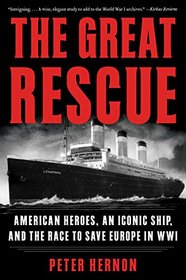I found this to be a very interesting book about World War I. It is also an easy read. However, from the image of the ship on the cover, I initially thought this to be a book about the German liner which was interned in the U.S. in August 1914, seized in 1917, and then converted into the largest U.S. troop ship of the war. But the liner, while its story is nicely told, serves mainly to connect multiple stories about the war and the people who fought in it.
In fact, the story begins way before America's entry into WW I. For example, it covers General Pershing chasing Pancho Villa in Mexico, an American war correspondent with the Germans in France, a member of the U.S. Congress quitting to enlist in the Army, and Army-Navy rivalries in who is to command what.
Later on we find out a lot more about General Pershing's French mistress, something you'd probably have to read a Pershing biography to discover.
The author also does a good job incorporating the "The Great Influenza," otherwise known as the "Spanish Flu," into the book. He lets you understand the effect of the flu on the war, but doesn't get bogged down in it. And he covers the participation of the Afro-American troops in the war, the prejudice they suffered from the American military, the high regard the French military and civilians had for them, and follows one Afro-American soldier's career from civilian to Medal of Honor awardee 70 years after the close of the war.
Once little thing which annoyed me was the author's believing everything Douglas MacArthur wrote in his autobiography. Historians have long known MacArthur was a great issuer of "Fake News," especially if it made him look better.
In this case, the author has Colonel MacArthur as the commander of the 42nd (Rainbow) Infantry Division. A division is commanded by a major general, not a colonel. The author really should have known this. Colonel MacArthur began as the chief of staff of the division, and, after promotion to brigadier general later in the war, commanded an infantry brigade in that division. While he did perform some heroics, at one time he accepted a medal for work performed by several of his battalion commanders nine miles from where he was. This formed a pattern for many of his actions in another war.
However, MacArthur did eventually command the 42nd Division. When the major general commanding the division was relieved on 10 November 1918, one day before the Armistice, and sent home due to the war's ending, MacArthur took command of the division and had that command for 1.5 days of the war. He was also sent home on 22 November, 1918, eleven days after the war ended. So he only commanded the division for 13 days. This very brief command stint is something MacArthur just happens to forget to mention in his own writings about his World War I experiences.
In fact, the story begins way before America's entry into WW I. For example, it covers General Pershing chasing Pancho Villa in Mexico, an American war correspondent with the Germans in France, a member of the U.S. Congress quitting to enlist in the Army, and Army-Navy rivalries in who is to command what.
Later on we find out a lot more about General Pershing's French mistress, something you'd probably have to read a Pershing biography to discover.
The author also does a good job incorporating the "The Great Influenza," otherwise known as the "Spanish Flu," into the book. He lets you understand the effect of the flu on the war, but doesn't get bogged down in it. And he covers the participation of the Afro-American troops in the war, the prejudice they suffered from the American military, the high regard the French military and civilians had for them, and follows one Afro-American soldier's career from civilian to Medal of Honor awardee 70 years after the close of the war.
Once little thing which annoyed me was the author's believing everything Douglas MacArthur wrote in his autobiography. Historians have long known MacArthur was a great issuer of "Fake News," especially if it made him look better.
In this case, the author has Colonel MacArthur as the commander of the 42nd (Rainbow) Infantry Division. A division is commanded by a major general, not a colonel. The author really should have known this. Colonel MacArthur began as the chief of staff of the division, and, after promotion to brigadier general later in the war, commanded an infantry brigade in that division. While he did perform some heroics, at one time he accepted a medal for work performed by several of his battalion commanders nine miles from where he was. This formed a pattern for many of his actions in another war.
However, MacArthur did eventually command the 42nd Division. When the major general commanding the division was relieved on 10 November 1918, one day before the Armistice, and sent home due to the war's ending, MacArthur took command of the division and had that command for 1.5 days of the war. He was also sent home on 22 November, 1918, eleven days after the war ended. So he only commanded the division for 13 days. This very brief command stint is something MacArthur just happens to forget to mention in his own writings about his World War I experiences.




